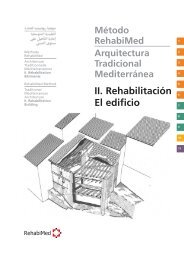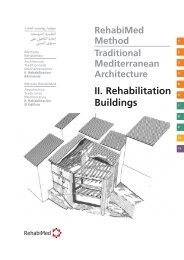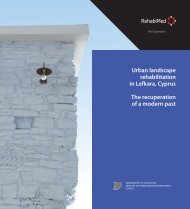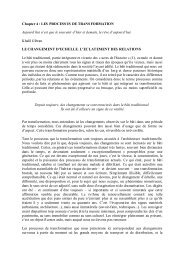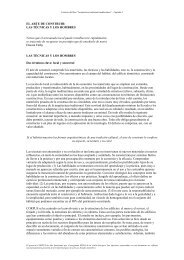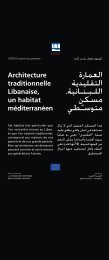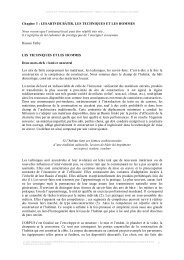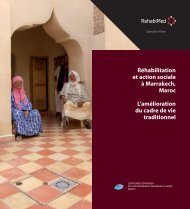La définition d'une stratégie d'intervention. La ... - RehabiMed
La définition d'une stratégie d'intervention. La ... - RehabiMed
La définition d'une stratégie d'intervention. La ... - RehabiMed
You also want an ePaper? Increase the reach of your titles
YUMPU automatically turns print PDFs into web optimized ePapers that Google loves.
<strong>La</strong> <strong>définition</strong> d’une <strong>stratégie</strong> d’intervention.<br />
<strong>La</strong> definición de una estrategia de intervención<br />
Defining a strategy for intervention<br />
Critical Analysis and Proposed Solutions<br />
Umm-Qais should be analyzed as a comprehensive region of both inside<br />
and outside the historic site. An attempt to identify landscape features<br />
and components in order to develop a comprehensive management<br />
and development plan.<br />
This critical analysis would identify the problems and potentials<br />
associated in the region of Umm-Qais. They have also pointed out<br />
the need for a usable, straight-forward system and methodology for<br />
addressing identification, evaluation, registration and management of<br />
these cultural and natural resources within the region. Work outside<br />
the historic site falls within two broad categories: work concerned<br />
with landscape understanding, and work concerned with landscape<br />
protection and management.<br />
In general, rural landscape management of Umm-Qais region has<br />
been concerned less with preservation than with the practicality<br />
and feasibility of proposed plans. Significant work in this area is not<br />
examined nor exists. One of the goals of our research is to unite the<br />
efforts of people working with natural and cultural resources and<br />
people concerned with agricultural land retention.<br />
Conservation & Development Plan<br />
The purpose of the conservation and development plan is to accelerate<br />
the conservation, development and rehabilitation of cultural resources,<br />
as well as improve the socio-economic benefits of the local community.<br />
In the other hand, enhance the environment protection. This will<br />
improve the capability of Umm-Qais region including local authorities<br />
and governing bodies to plan, develop, and carry out programs for<br />
resource conservation and development.<br />
As a part of this conservation plan we can exploit the potential of the<br />
Ottoman Village by a rehabilitation project. The village could be revived<br />
by using the buildings of the village as cultural clusters for handicrafts<br />
creation, which will be fully local in its implementation and utilization.<br />
The project intends to facilitate community-based socioeconomic<br />
development by creating culture-based industries (handicrafts and<br />
tourism) in areas adjacent to cultural heritage sites in the Ottoman<br />
village, while also improving the management of cultural assets,<br />
particularly at the local and national level. (Fig. 2)<br />
solution for the protection of Umm-Qais region and beyond that will<br />
maintain its significance for the future generation and enhance the<br />
sustainability of both natural and cultural resources in the region.<br />
Finally, archaeological sites should be treated not as isolated entities<br />
fro their settings but they should be treated as a whole context with<br />
its surroundings. As a result, a concrete comprehensive development<br />
and management plans could be established, which manage between<br />
cultural preservation and socio-economic development.<br />
REFERENCES<br />
- Bernard M. Feilden and Jukka Jokilehto, ICCROM (1993). Management Guidelines for World<br />
Cultural Heritage Sites, Rome.<br />
- Cesari, C. (1982). Considerations on the problems of integrated conservation. Lecture<br />
notes, ICCROM course in Architecture Conservation.<br />
- Feilden, Sir Bernard M.(1982). Conservation of Historic Buildings. Technical Studies in the<br />
arts, Archaeology and Architecture series. London.<br />
- Fitch, J, M. (1990). Historic Preservation: Curatorial Management of the Built World. New<br />
York.<br />
- Gill Chitty & David Baker, (1999) Managing Historic Sites and buildings. London.<br />
- Jokilehto, J. (1999). A History of Architectural Conservation. Oxford.<br />
- Kerner, S. (1990-1996), The Near East In Antiquity I-IV. Amman<br />
- Kennedy, D. (2000), The Roman Army in Jordan. London<br />
- Nielsen, I./F.G. Andersen/ S. Holm-Nielsen (1993), Die Byzantinischen Thermen (Gadara-<br />
Umm Qes 3: AbhDPV 18). Wiesbaden.<br />
- Segal, A. (1988), Town Planning and Architecture in Provincia Arabia. The Cities along the<br />
Via Traiana Nova in the 1st – 3rd Centuries. Oxford.<br />
- Thiel, W. (1998), Gadara-Umm Qais. Untersuchungen Zur ZEntwicklung Und Produktion<br />
Des Korinthischen Kapitells Im Urbanen Kontext Einer Stadt der Syrischen Dekapolis.<br />
Magisterarabeit Univ. Koeln. (maschinenschriftl)<br />
- Weber Thomas M. (2002), Gadara – Umm Qes I “Gadara Decapolitana”, Wiesbanden<br />
- Weber Thomas and R. G. Khouri (1989 1990nd) Umm-Qais – Gadara of the Decapolis. A<br />
Brief Guide to Antiquates. Amman<br />
We should take the following points in consideration for this<br />
rehabilitation project:<br />
1. Conducting social and needs assessment at the site;<br />
2. the development of mechanisms of community-driven<br />
development;<br />
3. the design of a monitoring and evaluation system for the project;<br />
4. a tourism assessment both at the project’s site and at the national<br />
level;<br />
5. the provision of technical assistance to design and implement<br />
capacity building interventions;<br />
6. improving the management of cultural assets at the project area;<br />
7. project management and control;<br />
Conclusion<br />
The general scope that we have taken in this research is the exploitation<br />
of the region’s valuable resources that are not yet fully invested nor<br />
managed properly. The establishment of heritage and cultural oriented<br />
projects; represented in the rehabilitation, for the region is the best<br />
205



